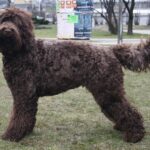
Introduction
When it comes to choosing a canine companion, understanding dog breeds plays a crucial role in ensuring a good match for your lifestyle. Among the myriad of dog breeds, the Schneagle has emerged as a delightful mixed breed, combining the characteristics of the Schnauzer and Beagle. With its unique traits, the Schneagle offers a blend of energy, intelligence, and affection that many dog lovers find irresistible. This article aims to provide a comprehensive guide on the Schneagle, covering its characteristics, care requirements, and suitability for potential owners.
Understanding Dog Breeds
What is a Dog Breed?
A dog breed is a specific group of domesticated dogs that share common traits, including physical appearance, behavior, and temperament. These characteristics are often shaped by selective breeding, which has led to a variety of breeds suited for different purposes, such as herding, hunting, or companionship. Understanding breed characteristics is essential for pet ownership, as it helps potential dog owners select a breed that aligns with their lifestyle and preferences.
The Role of Mixed Breeds
Mixed breeds, often referred to as “designer dogs,” are the result of breeding two distinct purebred dogs. These mixed breeds combine desirable traits from both parent breeds, which can lead to a more balanced and versatile pet. The popularity of mixed breeds has surged in recent years, with many potential dog owners drawn to their unique appearances and temperaments. The Schneagle is a prime example, offering the best of both the Schnauzer and Beagle in a single package.
The Schneagle: An Overview
History of the Schneagle
The Schneagle is a relatively new mixed breed, primarily developed in the United States. Its parent breeds—the Schnauzer and Beagle—each have rich histories. The Schnauzer originated in Germany, where it was bred as a multipurpose farm dog, known for its intelligence and protective nature. The Beagle, on the other hand, has roots in ancient hunting hounds, specifically bred for tracking and scent detection.
The combination of these two breeds into the Schneagle has resulted in a dog that is not only charming and affectionate but also possesses a strong hunting instinct and protective qualities.
Physical Characteristics
The Schneagle typically weighs between 20 to 40 pounds and stands about 12 to 16 inches tall. This mixed breed boasts a well-proportioned body that reflects its parentage. The coat can vary significantly, often depending on which parent breed’s traits dominate. Common coat types include short and smooth, similar to the Beagle, or medium-length and wiry, akin to the Schnauzer.
Colors can range widely: you might find Schneagles in classic Beagle colors like tri-color (black, brown, and white) or solid black or gray, reminiscent of Schnauzers.
Temperament and Behavior
The Schneagle is known for its friendly and outgoing personality. They are generally sociable dogs, thriving on human interaction and companionship. These dogs are known to be affectionate with their families and can be great with children, making them ideal family pets.
However, socialization is key. Early exposure to different people, pets, and environments is essential to ensure your Schneagle grows up to be a well-rounded adult dog. These dogs are also known for their playful nature and can get along well with other pets, especially if raised together.
Care Requirements for Schneagles
Nutrition
A well-balanced diet is crucial for the health and well-being of your Schneagle. High-quality dog food that meets the nutritional needs of a mixed breed is recommended. Look for food that lists meat as the first ingredient and is rich in protein, fats, vitamins, and minerals.
Feeding schedules should include two meals a day, spaced about 12 hours apart. Be attentive to portion sizes, as mixed breeds like the Schneagle can be prone to obesity if overfed.
Exercise and Activity Level
The Schneagle is an active breed that requires regular exercise to maintain its health and happiness. Daily walks, playtime in the yard, or engaging in agility training are excellent ways to keep your Schneagle physically stimulated. Aim for at least 30 to 60 minutes of exercise each day.
Additionally, mental stimulation is equally important. Puzzle toys and interactive games can help challenge your Schneagle’s mind and prevent boredom.
Grooming Needs
Grooming requirements for a Schneagle can vary based on its coat type. If your Schneagle has a wiry coat, regular brushing (at least once a week) is recommended to prevent matting. For shorter coats, occasional brushing will suffice to remove loose hair and dirt.
Bathing should be done as needed, particularly if your dog tends to get dirty during outdoor play. Nail trimming should be carried out regularly to avoid discomfort and potential injury.
Health Considerations
Like all breeds, Schneagles can be predisposed to certain health issues. Common concerns include hip dysplasia, ear infections, and eye problems. Regular veterinary check-ups are essential to monitor your dog’s health and catch any potential issues early.
Vaccinations, flea and tick prevention, and annual health screenings are critical components of preventative care for your Schneagle.
Training a Schneagle
Basic Obedience Training
Training is essential for the Schneagle, especially during the puppy stage. Early socialization and obedience training help ensure your dog grows into a well-behaved adult. Positive reinforcement techniques, such as treats and praise, work best with this breed.
Basic commands like sit, stay, and come should be taught early on, and consistency is key. Enrolling in a puppy training class can also be a beneficial way to socialize your Schneagle while learning basic commands.
Advanced Training
Once your Schneagle has mastered the basics, you can move on to advanced training. This can include learning tricks or even participating in dog sports like agility or obedience competitions. Engaging your Schneagle’s mind with these challenges can prevent behavioral issues that arise from boredom.
Intermediate and advanced commands can be taught using the same positive reinforcement methods. Ensuring your Schneagle remains mentally stimulated is crucial for a happy, well-adjusted pet.
Living with a Schneagle
Ideal Living Situation
The Schneagle adapts well to various living situations. Whether you live in an apartment or a house, your Schneagle can thrive as long as it receives adequate exercise and mental stimulation.
These dogs are particularly well-suited for families, singles, and seniors, as they are affectionate and loyal companions. However, families with young children should ensure that playtime is supervised to prevent any accidents or rough play.
Integration into a Family
Introducing a Schneagle to your family, including children and other pets, should be done gradually. Teach children how to approach and interact with the dog respectfully. Supervised introductions are essential to help all parties feel comfortable and secure.
Building a strong bond with your Schneagle involves spending quality time together through walks, play, and training sessions, which fosters trust and companionship.
Cost of Ownership
Owning a Schneagle involves several costs that pet owners should consider. Initial expenses can include adoption fees, supplies (like a bed, leash, and toys), and vaccinations.
Ongoing costs will include food, grooming, routine vet visits, and potential emergency medical expenses. Budgeting for these costs ensures you can provide the necessary care for your Schneagle throughout its life.
Finding a Schneagle
Adoption vs. Breeder
When considering adding a Schneagle to your family, you’ll need to decide between adoption and purchasing from a breeder. Adopting from a shelter or rescue organization can be a rewarding experience, as many dogs are in need of loving homes. Researching local shelters can lead you to a Schneagle in need of a second chance.
If you choose to buy from a breeder, ensure they are responsible and ethical. Look for breeders who prioritize the health and temperament of their dogs, provide health clearances, and encourage visits to meet the puppies and their parents.
Rescue Organizations
Numerous rescue organizations specialize in mixed breeds, including the Schneagle. These organizations often have various dogs available for adoption, allowing you to find a pet that matches your lifestyle. Research local rescues and consider reaching out to see if they have any Schneagles available for adoption.
Conclusion
The Schneagle is an endearing mixed breed that combines the best traits of the Schnauzer and Beagle. With its friendly disposition, moderate exercise needs, and adaptability, it makes a wonderful companion for various living situations.
As with any pet, responsible ownership includes understanding their needs, committing to training, and providing adequate care. If you’re considering bringing a Schneagle into your home, remember to thoroughly research and consider adopting from a shelter or reputable rescue organization to give a deserving dog a loving home.
By making an informed decision, you can enjoy the joys and companionship that the Schneagle offers, enriching both your life and that of your new furry friend.








